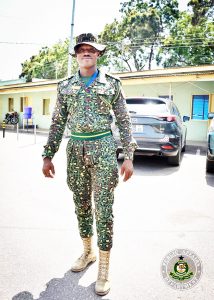
It is an undeniable fact that the paramilitary establishment, the Ghana Immigration Service (GIS), is presently on cloud nine after winning the admiration of both civilians and other security services by their conduct and appearance.
The men and women of the service now walk in their smart uniforms with chests out, corresponding with regimented paces.
Very uncommon for a state Security body to announce that her logistical needs have been fully met by government, but the GIS recently attested to an adequacy in such a support.
This heart-warming news could not have come but at a time when the unparalleled performance of personnel is required to keep in check persons migrating into our country and to stop insurgents coming into the country, after wrecking insecurity in the sub-region.

GIS as the first line of action has prepared its personnel to rise to the occasion in collaboration with other security agencies when a situation crops up. No wonder the service spends a large quota of her budgetary allocation to offer additional specialised training at the military and police institutions.
Since its establishment as the Immigration and Passport Unit of the Gold Coast Police Force and remained so until the attainment of independence in 1957 when it was ceded to the Ministry of the Interior, as a separate department solely responsible for immigration matters while the issuance of passports was transferred to the Ministry of Foreign Affairs.
This was at a time when the newly born Ghana’s economy, in addition to being the trailblazer in the African liberation struggle led to the influx of foreign businessmen, tourists and Africans.

The Aliens Act, 1963 (Act 160) was enacted to give legal backing to Immigration operations.
In 1989, by PNDC Law 226, the Immigration Department was converted into a paramilitary service with a supervisory board and a Director as the head.
The passage of the Immigration Act 2000, Act 573 gave the service the sole statutory mandate to regulate and monitor entry, residence, employment and exit of foreigners in the country.
GIS’s marriage with the Ghana Police Service saw Commissioners of Police (COP) on secondment as Directors from time to time, beginning with Mr Ernest Owusu Poku who later became the Inspector General of Police (IGP).
Mr S.S. Oman, W. K Aboah, Nana Owusu Nsiah, Her Excellency Elizabeth Adjei, Mr Dr Peter A Wiredu and Felix Yaw Sarpong were past Directors of the service.

The first Controller General of Immigration (CGI), Mr Kwame Asuah Takyi, the former Head of Legal Department, took over on the 31st of May, 2017 and under his administration have been tremendous transformations in the service, which prior to his takeover had a manpower strength of 3,250 (Three thousand two hundred and fifty) but is now running over 13,000 (Thirteen thousand) personnel.
The government of President Nana Addo Dankwa Akuffo-Addo has vowed to put the GIS on a global pedestal, ably supported by the indefatigable Minister of the Interior, Ambrose Derry, through the instrumentality of the CGI have achieved a lot since assuming Office.
The current administration not only brought about more infrastructural development at the Immigration Service Academy and Training School, AssinFosu, but established two, the Immigration Service Tactical Training School at Kyebi and the GIS Mid- Country Training School at Tepa in the Ashanti Region.
Information available to The Chronicle from the service indicates that CGI Asuah Takyi has allotted between 15:00hrs and 22:00hrs of every Friday, provided that he is within the jurisdiction, to attending to personal welfare matters.








